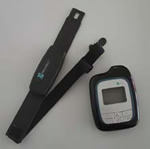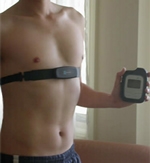Update (August 2013): The HypoMon was recalled from the market after Australia’s TGA determined its real-world detection performance was below what the labeling specified. Users were advised to return units for a refund, and the product has not been marketed since.
Looking for current options? Today’s continuous glucose monitors (CGMs) offer configurable low-glucose alerts and sharing features that help detect and respond to nighttime lows. See the ADA overview of CGMs or our CGM comparison (Dexcom, Libre, Guardian) for alert features and pros/cons.
Similar to the Sleep Sentry, the HypoMon® noninvasively detects hypoglycemia during sleep. It was specifically designed for children and young adults with Type 1 between the ages of 10 and 25. It is specifically for sleep-time hypoglycemia.


The HypoMon® system includes a battery-powered sensor worn on your chest and a monitor. The Hypomon doesn’t measure actual blood glucose levels. Instead, the sensor recognizes and measures the body’s physiological responses to changes in BG levels, specifically those related to lows. When certain physiological reactions are seen, the sensor wirelessly transmits an alarm to the monitor up to 10 feet away, similar to the mySentry Remote Glucose Monitor from Medtronic. One thing to consider is that hypo unawareness can vary between people, so you may not get the expected alarms if your responses fall outside their tested range. You should speak with your health professional about your hypo unawareness before using a device like the Hypomon.
Before bed, the user must take a standard blood glucose test and enter the result into the monitor. The HypoMon should not be used if you have measured a blood glucose level < 45 mg/dl (2.5 mmol/L) within 12 hours or < 72 mg/dl (4.0 mmol/L) immediately before intended use. If an alarm sounds during the night, the user must check their blood glucose levels and enter the new reading into the monitor. This alarm allows the patient and/or caregiver to treat the hypoglycemia at an earlier stage.
The signal between the sensor and monitor works like a standard Wi-Fi setup on a computer. The effective range of sensor-to-monitor communication can be affected by wall density and electromagnetic interference, such as that from computers, routers, cordless phones, and satellite transmitters.
Some drawbacks of the Sleep Sentry may also be present in this device. For instance, movement or sweat often triggered false alarms in the Sleep Sentry. A particularly hot night or constant tossing and turning can result in many alarms throughout the night. AIMEDICS says that false hypos that are not occurring occur in only about 4 out of 20 nights.
About AIMEDICS
AiMedics, established in October 2001 as a commercial spin-off of the University of Technology, Sydney (UTS), specializes in non-invasive monitoring for various diseases, including diabetes, epilepsy, fatigue, and Sudden Infant Death Syndrome. It has been funded through a series of investments and government grants: BIF, NSW Government, Juvenile Diabetes Research Foundation (through UTS), and the Australian Government. Note: HypoMon was recalled in 2013 and is no longer marketed.
Last Updated on October 15, 2025
